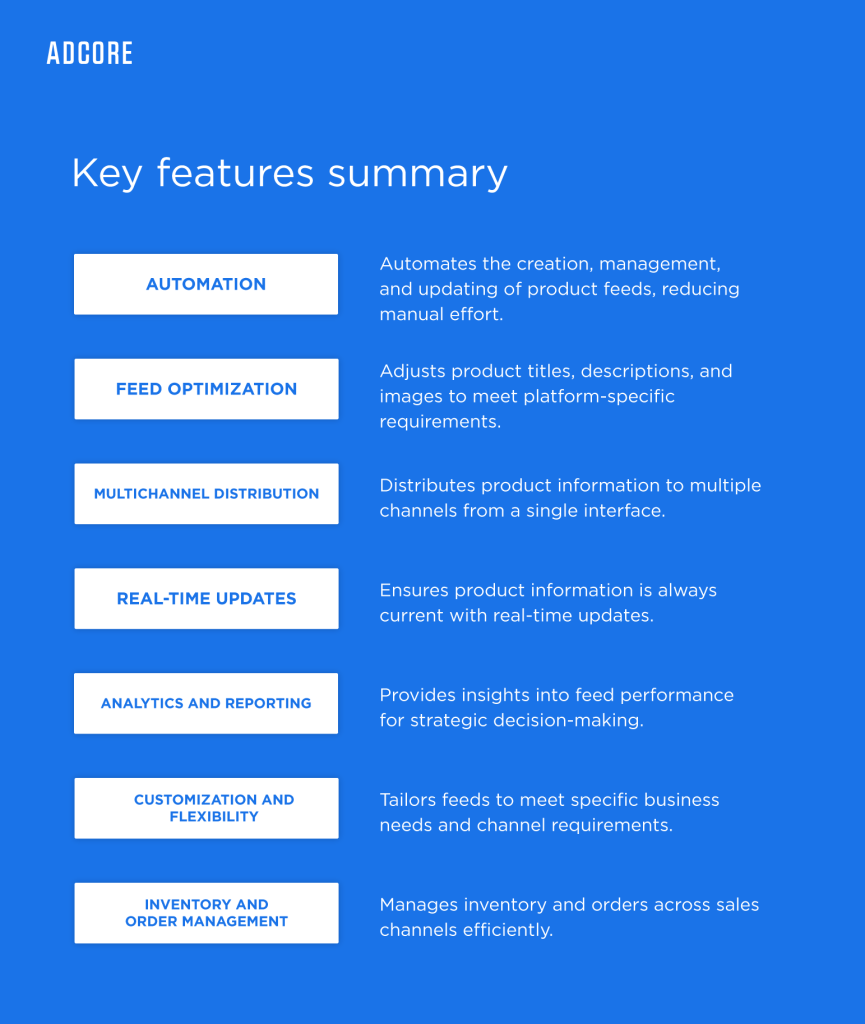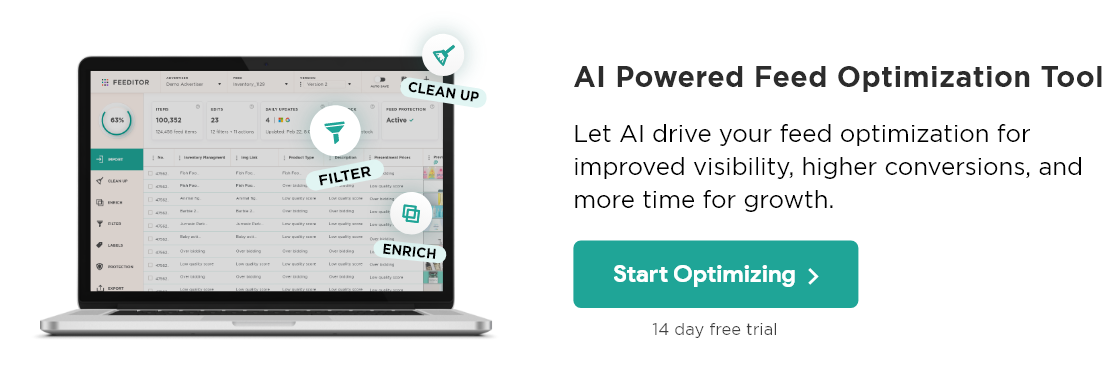As online shopping has grown immensely in past years, there are more customers, across more channels, to advertise to than ever. The potential for sales is huge, but a competent marketing strategy is required. Given the sheer amount of potential customers, managing every single product feed for every single channel can be quite a task. Imagine how many customers you could be missing out on, just because you forgot to manually update one small aspect of your feed. Feed management services solve this issue. They automate the tedious tasks so that you can focus on the strategy and vision of your company.
A product feed starts with a file that contains all the necessary information about your products, including titles, descriptions, prices, images, and more. This file can be formatted in various ways, such as XML, CSV, or TXT, and is used to share product information with online marketplaces (such as Google), comparison shopping engines, and other sales channels. Feed management services take these product feeds and optimize them for better performance across different platforms. This includes ensuring your product information is accurate, up-to-date, and formatted correctly to meet the specifications of each sales channel. Effective feed management can streamline your operations, improve your product visibility, and ultimately drive more sales.
Feed management refers to the systematic process of organizing, optimizing, and distributing product data to various online marketplaces, comparison shopping engines, and other sales platforms. This starts with creating and maintaining a product feed file, which contains all the relevant information about the products you sell, such as titles, descriptions, prices, images, availability, and other attributes.
Feed management services handle a wide range of tasks to keep your product information accurate and consistent across all channels. They automatically update product details like prices and stock levels, filter out products that don’t meet your criteria, and optimize listings to make them more attractive to potential buyers. The benefits of using a feed management service include increased control over your product information, automation of routine tasks, dynamic updates to keep your listings current, enhanced security to ensure data accuracy, and improved efficiency to save both time and money.
How Can Feed Management Benefit Your Business?
The main purpose of feed management is to ensure that your product information is consistent, accurate, and optimized for each sales channel. This helps in:
- Maintaining Data Accuracy: Ensuring that product details like prices, stock levels, and descriptions are always current.
- Improving Product Visibility: Optimizing product listings to make them more attractive and discoverable to potential buyers.
- Enhancing Customer Experience: Providing accurate and detailed product information to help customers make informed purchase decisions.
- Streamlining Operations: Automating routine tasks to save time and reduce the risk of errors.

Main Components:
To understand feed management better, it’s important to know the key components involved:
- Product Feed Creation: Compiling all relevant product information into a structured file format (XML, CSV, or TXT).
- Feed Optimization: Adjusting product data to meet the specific requirements of each sales channel, including optimizing titles, descriptions, and images.
- Feed Distribution: Automatically distributing the optimized product feed to various sales channels.
- Real-Time Updates: Keeping product information up-to-date with real-time changes in prices, stock levels, and other attributes.
Analytics and Reporting: Monitoring feed performance across channels to identify areas for improvement and optimize product listings.

Importance of Feed Management in ECommerce
Feed management plays an important role in ensuring that your products are accurately represented across all platforms. Consider an eCommerce business that manually updates its product listings. Every time there’s a change in price or stock, the team has to update each listing across all sales channels manually. This process can be extremely time-consuming and prone to errors, which might result in customer dissatisfaction and lost sales.
Now, imagine the same business using a feed management service. Product information is automatically updated in real-time across all channels. Out-of-stock items are immediately removed from listings, and product descriptions are optimized for better visibility and conversion rates. This automation frees up the team to focus on more strategic tasks, ultimately leading to a more efficient and profitable operation.
In the following sections, we’ll dive deeper into the various aspects of feed management, exploring its benefits, key functions, and how you can implement it in your eCommerce business to achieve better results.
Key reasons why feed management is important:
- Consistency: Maintaining consistent product information across all sales channels helps build trust with customers and reduces the likelihood of errors.
- Efficiency: Automating the feed management process saves time and resources, allowing you to focus on more strategic activities.
- Scalability: As your business grows, feed management tools can handle larger volumes of product data and more sales channels without compromising accuracy or efficiency.
- Competitiveness: Optimized product feeds improve your chances of ranking higher in search results on marketplaces, leading to increased visibility and sales.
As Willem Stam of Postmastery puts it, “Move towards the data instead of the other way around; senders will need more data points to personalize communication that will drive user engagement.” A proper feed management strategy will help you step up your ability to leverage data points and engage shoppers with customized ads. With detailed analytics, you can tailor your strategies to meet customer needs and enhance engagement.
Benefits of Feed Management
Control
One of the primary benefits of feed management is the control it provides over your product information. With feed management tools, you can centralize data management, allowing you to oversee all your product data from a single platform, ensuring consistency across all sales channels. These tools also enable customizable feeds, letting you tailor your product feeds to meet the specific requirements of each sales channel. This ensures that your listings are always optimized. For example, Amazon requires detailed product specifications, such as brand, manufacturer part number, and item dimensions. Feed management services allow you to include these details in your product feed for Amazon but exclude them for simpler platforms like Facebook Marketplace.
Additionally, real-time updates are a significant feature, allowing you to instantly update product information across all channels, reducing the risk of outdated or inaccurate listings. Manually managed product feeds might not adjust to a product being out of stock fast enough, resulting in shoppers trying to buy something that is no longer available. This wasted ad spending and can lead to customer dissatisfaction.
Main Control Benefits:
- Centralize Data Management: Manage all your product data from a single platform, ensuring consistency across all sales channels.
- Customizable Feeds: Tailor your product feeds to meet the specific requirements of each sales channel, ensuring that your listings are always optimized.
- Real-Time Updates: Instantly update product information across all channels, reducing the risk of outdated or inaccurate listings.
Automation
Automation is a key feature of feed management tools, offering significant time and resource savings. Automatic feed generation allows you to create and update product feeds without the need for manual intervention, thus saving considerable effort. Dynamic pricing and stock updates ensure that prices and stock levels are updated in real-time, maintaining the accuracy of your listings. A product’s price can be raised automatically once stock levels drop. Additionally, you can schedule updates to occur at specific intervals, ensuring that your product information remains up-to-date at all times.
Main Automation Benefits:
- Automatic Feed Generation: Generate and update product feeds automatically, eliminating the need for manual updates.
- Dynamic Pricing and Stock Updates: Automatically update prices and stock levels in real-time, ensuring that your listings are always accurate.
- Scheduled Updates: Schedule feed updates to occur at specific intervals, ensuring that your product information is always up-to-date.
Are you running Learn how to automate feed management in Google Ads.
Efficiency
Feed management tools significantly improve the overall efficiency of your eCommerce operations. By automating routine tasks, these tools free up time for more strategic activities, allowing you to focus on growing your business. They also help in reducing costs by preventing the running of ads for out-of-stock products, thereby saving on advertising expenses and improving return on investment (ROI).
A quality feed management tool can help you optimize listings with enhanced titles, descriptions, and images. Doing so will not only make your product listings more attractive, it also makes targeting customer profiles more efficient thanks to accurate keyword data.
Main Efficiency Benefits:
- Saving Time: Automating routine tasks frees up time for more strategic activities, allowing you to focus on growing your business.
- Reducing Costs: Avoid running ads for out-of-stock products, saving on advertising costs and improving ROI.
- Upgrade Listings: Improve the targetability and conversion rate of your listings with optimized titles, descriptions, and images.
Get started now. Click here for 3 quick product feed edits that boost your ROI.
Top 5 Benefits
Feed management tools offer a variety of functions that significantly streamline and enhance your eCommerce operations. Understanding these applications can help you improve your overall business efficiency. Here, we’ll delve into some of the primary functions that feed management tools provide.
1. Publish Your Product Listings Quickly
Product feed services are designed to handle the specifications and categories of various channels, making it straightforward to connect your product catalog with multiple marketplaces. This means that even if your feed changes frequently, you can quickly update your listings across all platforms, ensuring that your products are up-to-date and optimized for each marketing channel.
2. Constantly Update Product Information
Feed management tools ensure that any changes in your eCommerce product information are immediately reflected across all your sales channels. Whether it’s price adjustments, stock updates, or new product additions, these tools help you maintain accurate and current product information everywhere you sell.
3. Exclude Products You Are Not Interested in Selling
Not all products are suitable for all platforms, and feed management tools make it easy to filter out products you don’t want to list. For example, you can exclude out-of-stock items to avoid customer frustration, filter out products without images to maintain a professional appearance, and remove low-priced items that might not be profitable on certain marketplaces.
4. Optimize the Information You Are Publishing
Optimization is a crucial aspect of feed management. The more complete and detailed your product information, the higher the likelihood of conversion. Feed management tools allow you to enhance product titles, descriptions, and images to make your listings more appealing, ensuring all essential details are included.
5. Integration of Orders with Marketplaces
Managing orders from multiple marketplaces can be challenging, but feed management tools simplify this process by integrating orders directly with your eCommerce platform. Whether your store is developed on Magento, PrestaShop, Shopify, or WooCommerce, you can receive and manage orders from various marketplaces such as Amazon, Carrefour, or Fnac from a single interface, improving efficiency and quality in order management.
Make sure you have all the different information for your product feed. Here’s a guide to the required fields of product feed specification.

Market Growth and Importance
With the exponential growth of online shopping, the importance of reliable product feed tools has increased significantly. Over the past decade, eCommerce has transformed from a niche market to a dominant force in the global economy. According to Statista, global eCommerce sales are projected to reach $8.034 trillion by 2027, a substantial increase from $3.351 trillion in 2019. This rapid growth underscores the need for businesses to maintain accurate and up-to-date product information across various platforms to stay competitive.
Adapting to Consumer Behavior
Consumer behavior has shifted dramatically towards online shopping due to its convenience, variety, and often competitive pricing. As a result, eCommerce businesses must ensure that their product information is not only accurate but also optimized for visibility and conversion across multiple channels. This means keeping up with frequent changes in product details such as prices, stock levels, and descriptions, which can be a daunting task without the right tools.
Supporting Multichannel Strategies
Today’s eCommerce landscape is highly fragmented, with consumers shopping across a myriad of platforms, including Amazon, eBay, Google Shopping, and various niche marketplaces. Product feed tools are crucial in supporting a multichannel strategy by allowing businesses to manage and update their product data from a single interface. This ensures consistency and accuracy across all platforms, helping businesses reach a wider audience and increase sales.
Enhancing Global Reach
As eCommerce continues to grow, so does the opportunity to reach a global audience. Product feed tools enable businesses to expand their reach by supporting multiple languages and currencies, and by complying with the specific requirements of different international marketplaces. This flexibility allows brands to tap into new markets with ease, driving growth and increasing their global footprint.
Implementing Feed Management in Your Business
Implementing feed management in your eCommerce business is essential for updating and improving product data, enhancing visibility, and driving sales. One of the most effective tools available for this purpose is Feeditor, a tool designed for companies to easily oversee and optimize their product feed for a better all-round performance.
Feeditor
Feeditor, revolutionizes product feed management for businesses of all sizes. It allows users to edit their product feeds in real-time, significantly improving the quality of both the feed and the underlying data. Whether you need to perform comprehensive bulk modifications or meticulous fine-tuning, Feeditor offers extraordinary adaptability. Unlike other services, this tool allows for constant oversight of your feed to check how updates will look like in real-time. Priced affordably at $33.99 per month, it is ideal for everyone from individual marketers, agencies, to large-scale global brands.
How Feeditor Enhances Your Feed Management
- Quick Adaptation to Market Changes: Update your product feeds instantly to reflect inventory changes, pricing adjustments, or promotional offers, keeping your listings competitive and up-to-date.
- Enhanced Listing Quality: Use Feeditor’s AI-powered enrichment features to optimize your product titles, descriptions, and images, improving visibility and appeal to potential buyers.
- Streamlined Bulk Editing: Apply changes across multiple products effortlessly, saving time and reducing the risk of errors, ensuring your listings remain accurate and compelling.
- Seamless Integration: Feeditor integrates flawlessly with leading ad shopping platforms and merchant centers, enhancing your advertising reach and ensuring consistency across all channels.
Are you ready to elevate your product feed management to new heights of efficiency and effectiveness? Try out Feeditor to optimize your product feeds and turn potential into performance. Still unsure? Feeditor offers a free 14-day trial, so you can give it a test run!
Conclusion
The real magic happens when you start viewing feed management not just as a technical necessity, but as a strategic tool. It’s about more than just keeping data clean and up-to-date—it’s about using that data to connect your customers with your products. By taking the time to optimize each aspect of your feed, you are setting the stage for a seamless and engaging shopping experience that resonates with your customers and keeps them coming back.
Leveraging the features and capabilities of Feeditor,can help you optimize your feed management, save time, and achieve better results in your eCommerce operations. Don’t miss out on the opportunity to enhance your product listings and improve your overall business performance with Feeditor.
Are you ready to take your eCommerce business to the next level? Implementing a powerful feed management tool like Feeditor can transform your product feed strategy, ensuring that your listings are always optimized and up-to-date. Discover how Feeditor can help you streamline your feed management processes, improve your product visibility, and drive more sales. Get started with Feeditor today!
Trending Articles
Get exclusive CMO tips that I only share with email subscribers.
Related Articles
